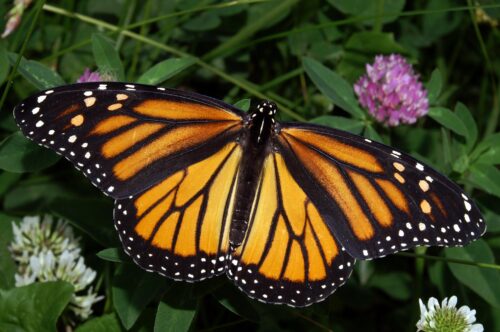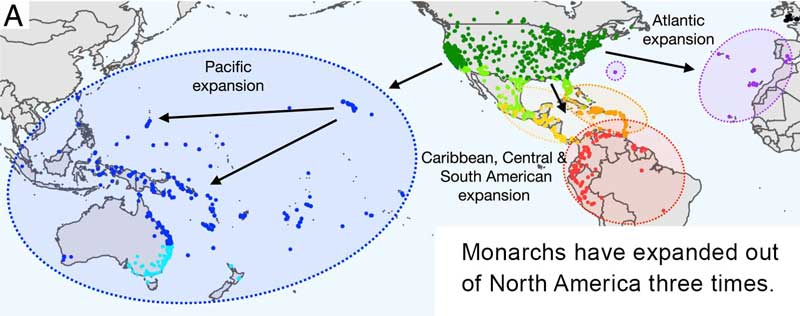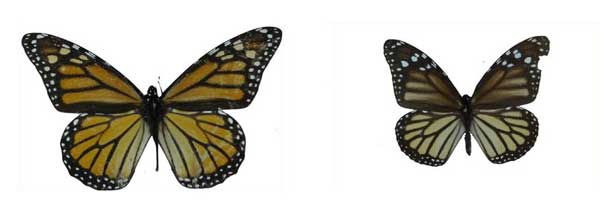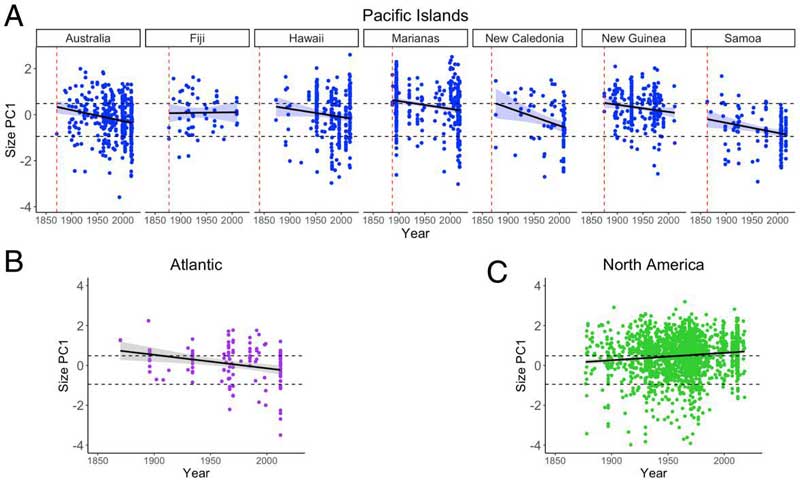
This year, many Americans are refraining from holiday travel to slow the spread of COVID-19. While we are stuck at home, though, many of us can look out the window or take a walk to appreciate a different sort of annual trek, one that continues in full swing … or, in this case, full wing. During their annual migration in the fall, monarch butterflies travel from their summer range across North America to warmer sites in Mexico and the southern United States, where their food plant (the milkweed Asclepia) is available even in the dead of winter. They make the return trip in the spring. In the last few weeks, monarchs have been spotted in most southern U.S. states and in central Mexico as they leave the cold weather behind. This trip is a true family affair. No single butterfly will live long enough to make the entire return trip; instead they breed en route. However, some monarchs skip the family vacation entirely. Over the last 200 years, monarchs have spread around the world, seeding populations that stay put and don’t migrate at all. Now, new research reveals the evolution that accompanied and follows these colonizations.
Where's the evolution?
Native to North America, monarchs have recently spawned populations across the Pacific (in Australia, New Zealand, and the Pacific Islands) and Atlantic (in Spain and the Canary and other Atlantic Islands). Milkweed grows year-round in these areas, and, for the most part, the new populations don’t migrate. These non-migratory populations also tend to have smaller wings than migrating monarchs, which have larger, more elongated wings.

Why? The hypothesized explanation is intuitive. Natural selection spreads heritable traits that help an individual survive and reproduce more than other. Perhaps large, elongated wings are favored by natural selection when one’s survival and reproduction depend on being able to flap more than a thousand miles, and so spread through migrating populations. But when a butterfly can provide its caterpillars with plenty to eat just by staying in one area, long wings don’t offer any advantage. This hypothesis makes sense, but of course, science relies on evidence, not just plausibility.
If elongated wings functioned in this way as monarchs spread around the globe, what would we expect to observe? We might expect that the first wave of monarch migrants to reach new territories would have had longer wings than average, as shorter winged butterflies would be less likely to make it across the Pacific or Atlantic oceans. This bias in the new arrivals would lead to a new population of particularly long-winged butterflies that stay put in their new home and do not migrate. But then, over many generations in which long wings offered no selective advantage (or perhaps even a disadvantage) to the homebody butterflies, we would expect the population to evolve shorter wings.
Checking this expectation might at first seem impossible. We can’t go back in time and measure the wings of monarchs as they established populations on other continents. But we can go into natural history museum collections. The collections in these institutions represent more than just an educational diversion for tourists on a rainy day. They are also biological time capsules, preserving specimens of Earth’s biota, often for hundreds of years. Studies of museum collections have contributed to many fields, for example, by helping us track infectious diseases and identify new crop pests. And of course, they are invaluable in studies of historical changes in life on Earth, like the new monarch research. Colorful butterflies, a popular target for amateur and professional collectors, are particularly well represented in these collections, and so the researchers were able to base their work on more than 6000 monarch specimens from different museums dating back to 1856.

The scientists behind the new study measured the wings of these long dead butterflies, collected at different points in time and from different regions around the world. They found that the first monarchs collected from across the Atlantic and Pacific Oceans had larger, more elongated wings than those collected around the same time in North America. So it seems likely that long wings did help butterflies get across the ocean. However, in later years, butterflies collected from these same areas across the Atlantic and Pacific had shorter and shorter wings. This same pattern was seen over and over again in eight different locations. During the same time period, North American monarchs went in the opposite direction: the specimens collected had larger and larger wings over time. Today, there is a noticeable difference between migratory and nonmigratory monarchs. For example, in the monarchs shown to the left, the front wings of the migratory monarch are 40% larger than those of the nonmigratory butterfly. All of these observations make sense if monarchs’ wings are the target of natural selection, with extra-long wings boosting survival and reproduction for those that must travel long distances.

To make sure that the difference they observed in wing size and shape was caused by a change in the genes in each population and not by some difference in the environment that different populations occupy, the researchers performed an experiment. They raised monarchs from different populations (starting as eggs) in the same way in the same greenhouse on the same plants. If wing differences between populations were caused by environmental differences, then those differences should disappear when the monarchs all experience the same environments for their entire lifespan. But in these lab-raised caterpillars, the differences persisted. Monarchs from North American stock still had the largest wings, and monarchs with nonmigratory ancestors still had smaller wings. The differences between populations really is rooted in genetic differences between populations — and hence, is best explained by evolution.
The new research makes clear the value of large, elongated wings, but it does not explain exactly why nonmigratory populations evolved shorter wings. It could be that shorter wings themselves offer an advantage in nonmigratory populations — for example, if short wings require less energy to grow and use, or if short wings make it easier to avoid being caught by a hungry bird. In these cases, once a nonmigratory population was established, natural selection would lead to the evolution of shorter wings. Each generation, individuals that just happened to have genes leading to shorter wings would leave behind more offspring than their longer-winged counterparts, spreading genes that produce short genes. Alternatively, it could be that neither short wings nor long wings offer any particular advantage in nonmigrating populations. In this case, the genes responsible for making extra-long wings would have randomly acquired mutations that cause them to be less functional (i.e., produce shorter wings). But since having long wings is not helpful in this situation, natural selection would not have weeded out these mutations (as would have happened in a migratory populations), allowing the broken genes to spread by genetic drift. Eventually, the population would evolve shorter wings merely because of the accumulation of random mutations interrupting the function of genes that were previously honed by natural selection. Whatever the explanation, the new research makes clear that evolution happens on timescales that we can directly document (in this case, by tapping into museum collections) and observe in the world around us, sometimes right outside our own windows.
Similar lessons apply to Earth’s many other migrating species. As human activities continue to warm the planet and change ecosystems, we can expect to see even more disruptions to species’ migratory patterns and ranges. These are likely to trigger evolutionary shifts, just as we’ve seen in monarchs. And as we investigate these shifts, one resource will be invaluable for understanding how we are remaking life on Earth: museum collections.
Primary literature:
- Freedman, M., G., Dingle, H., Strauss, S. Y., and Ramírez, S. R. (2020). Two centuries of monarch butterfly collections reveal contrasting effects of range expansion and migration loss on wing traits. Proceedings of the National Academy of Sciences of the United States of America. 117: 28887-28893. Read it »
News articles:
- An explanation of the new research from The California Aggie
- A quick summary of the findings from Science Daily
Understanding Evolution resources:
- The basics of how natural selection works to produce adaptations
- A tutorial on common misconceptions about natural selection and adaptations
- A quick explanation of genetic drift
Background information from Understanding Global Change:
- What trait is being shaped by natural selection in migrating monarchs?
- Imagine that migrating monarchs from North America colonize a region of Portugal where milkweed grows year-round and establish a non-migrating population there.
- Sketch a graph with time on the x-axis and wing length on the y-axis showing how you would expect wing length to change over time in this population.
- Sketch another graph as above, but this time imagine that, 50 years after the Portuguese population was established, hundreds of migratory butterflies from North America, blown by a storm, arrive in the area and interbreed with the local population.
- In your own words, explain the role that museum collections played in testing the idea that monarch wing size evolved in nonmigrating populations of monarchs.
- Read about phenotypic plasticity. Does phenotypic plasticity explain the differences in the wings of migratory and nonmigratory monarchs? What test did the researchers perform to answer this question? Explain the test and their reasoning.
- Teach about natural selection: In this classroom activity for grades 9-12, students experience one mechanism of evolution through a simulation that models the principles of natural selection and helps answer the question: How might biological change have occurred and been reinforced over time?
- Teach about evolution, climate change, and phenotypic plasticity: This article for grades 9-12 follows scientist Jennifer McElwain as she studies the fossil record in order to learn more about how global warming has affected life on Earth in the past and how it might affect life on Earth in the future. This article comes with a set of discussion questions for use in the classroom.
- Freedman, M., G., Dingle, H., Strauss, S. Y., and Ramírez, S. R. (2020). Two centuries of monarch butterfly collections reveal contrasting effects of range expansion and migration loss on wing traits. Proceedings of the National Academy of Sciences of the United States of America. 117: 28887-28893.
- Suarez, A. V., and Tsutsui, N. D. (2004). The value of museum collections for research and society. Bioscience. 54: 66-74.
